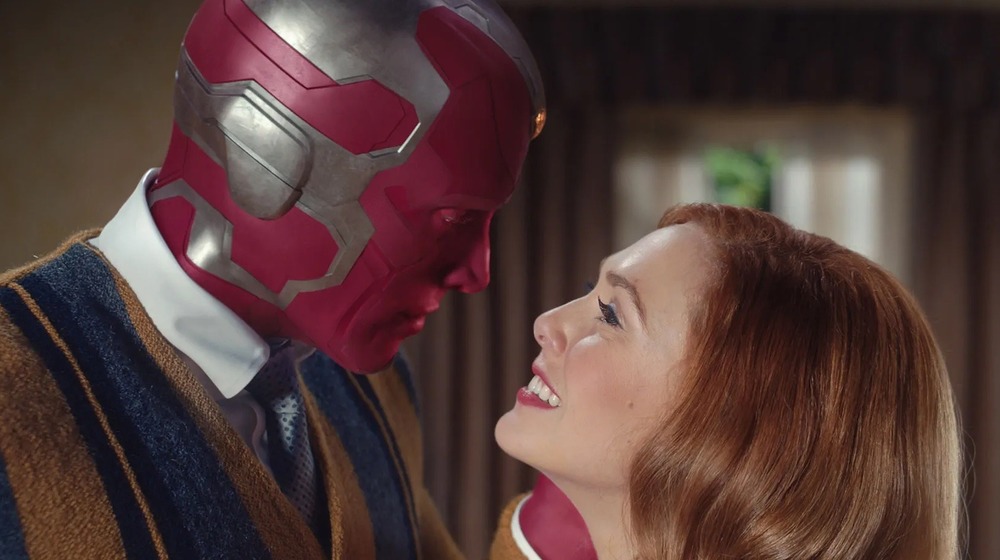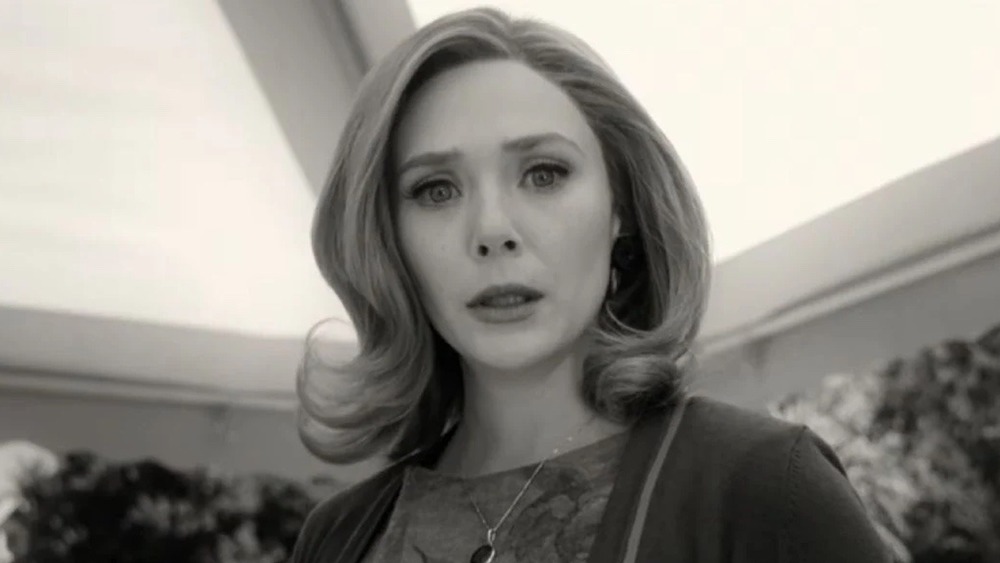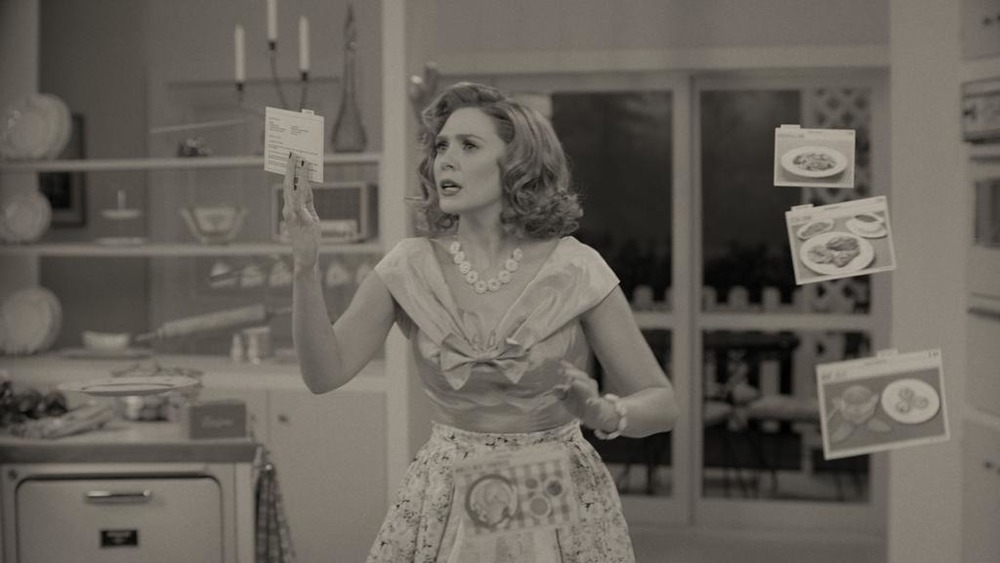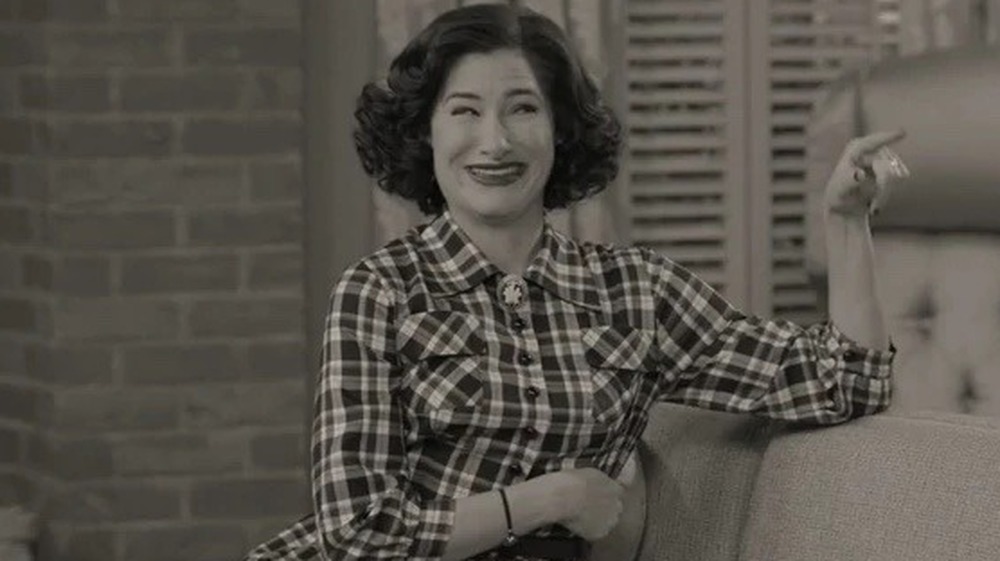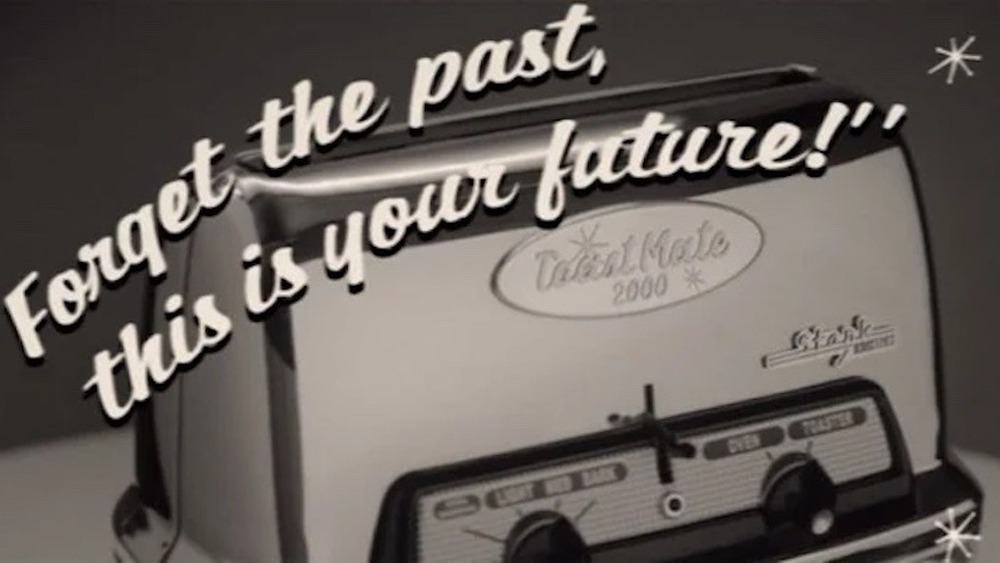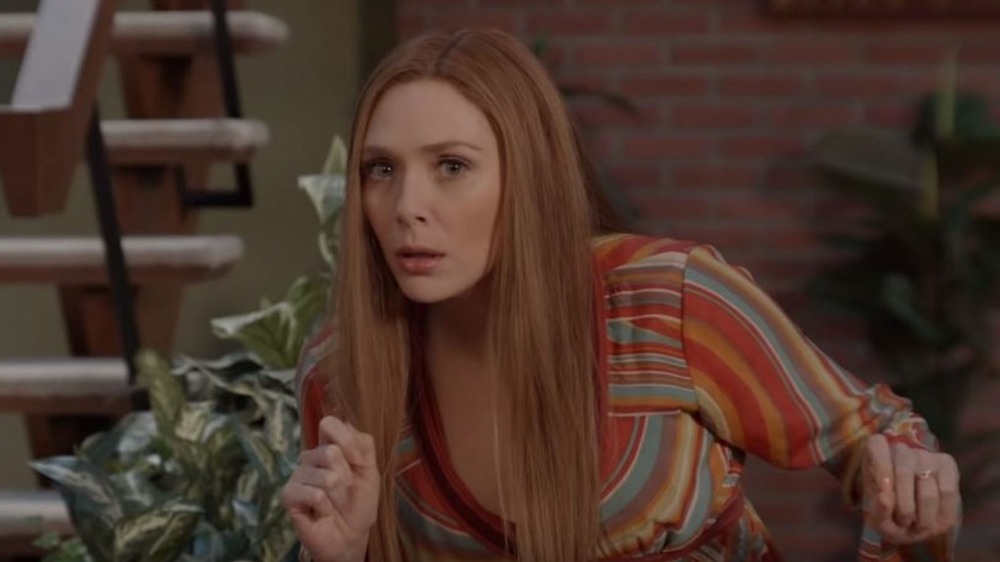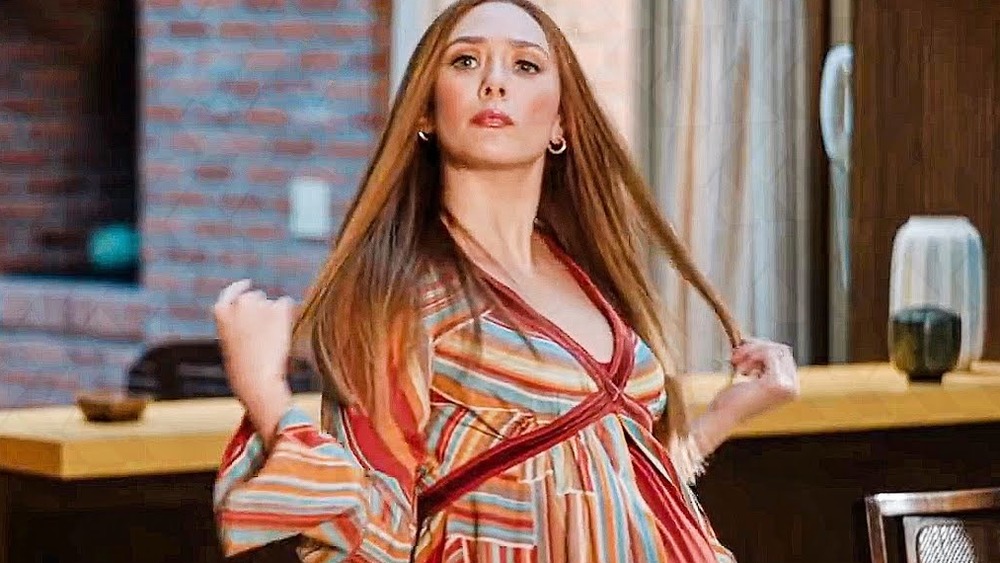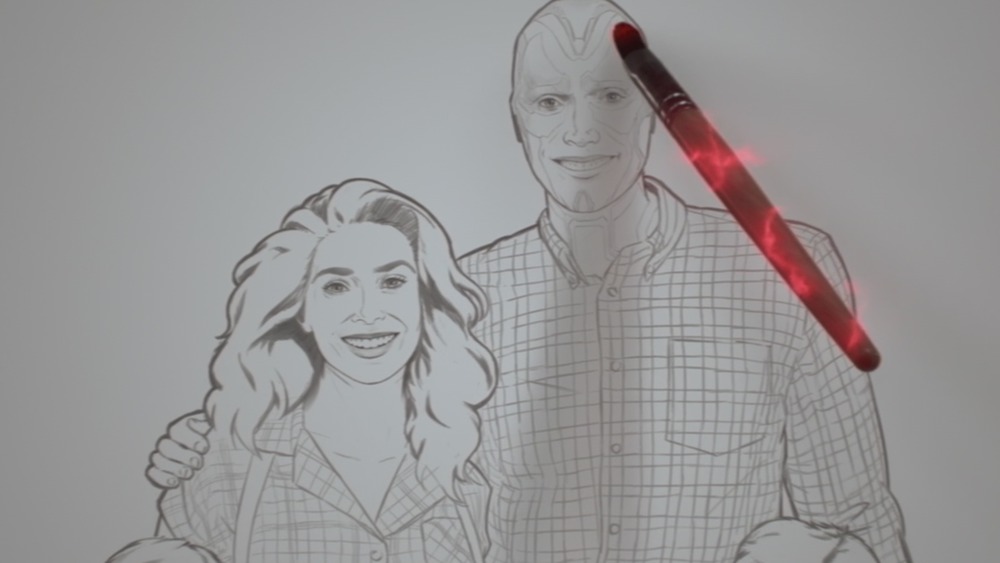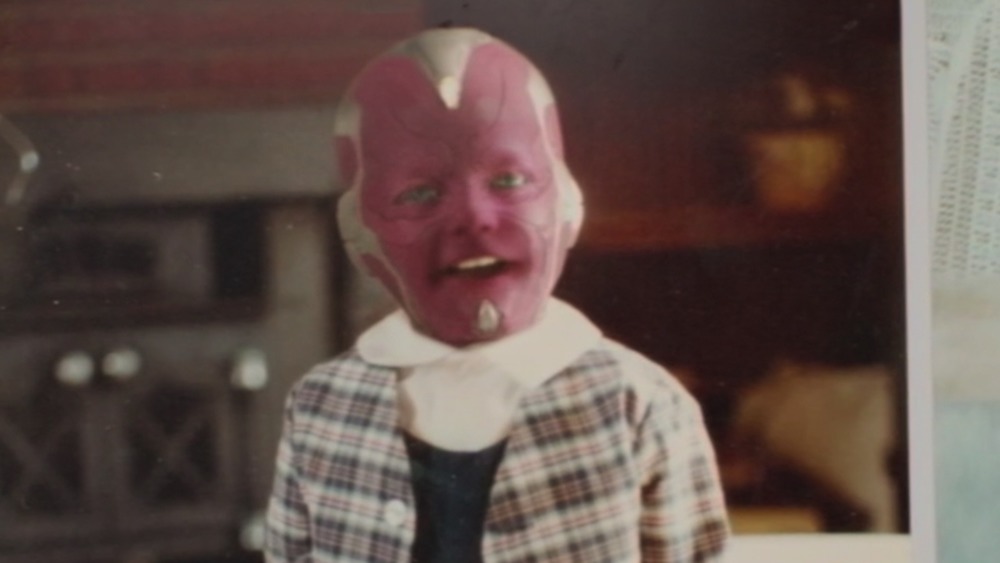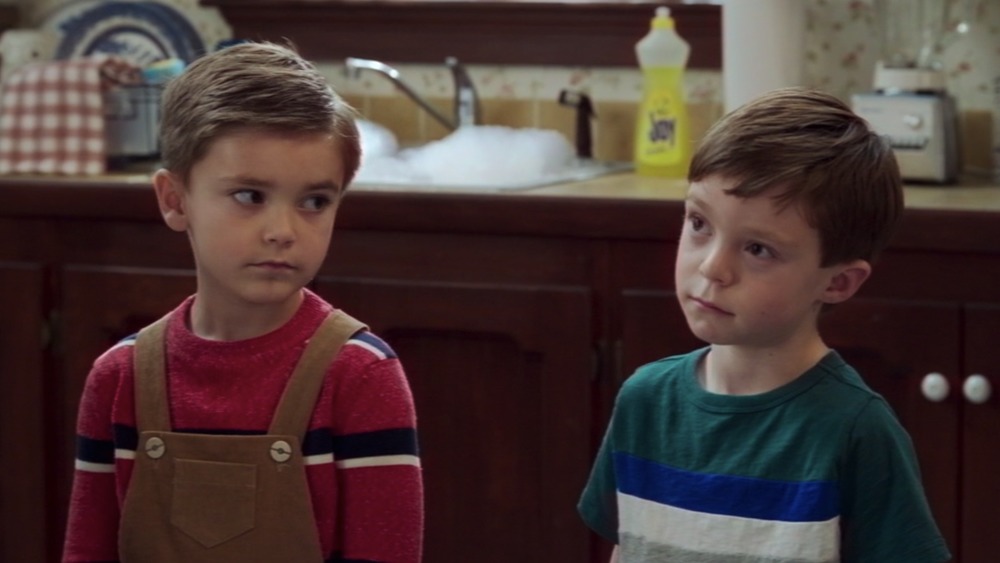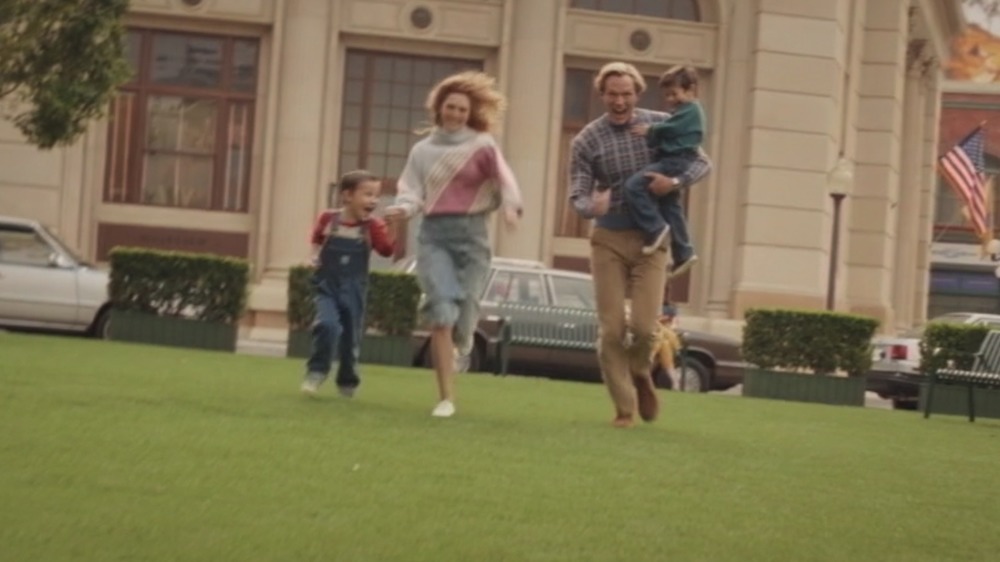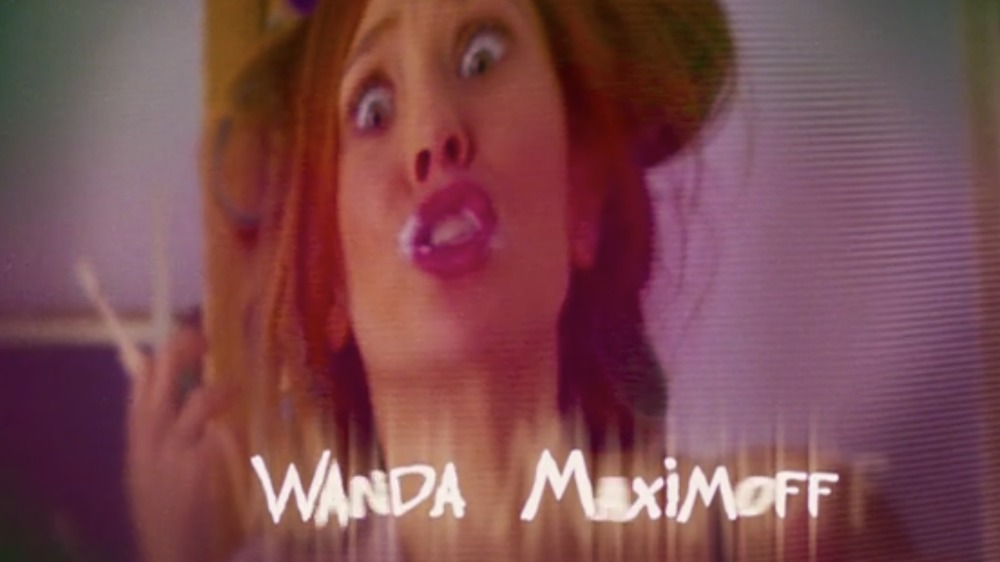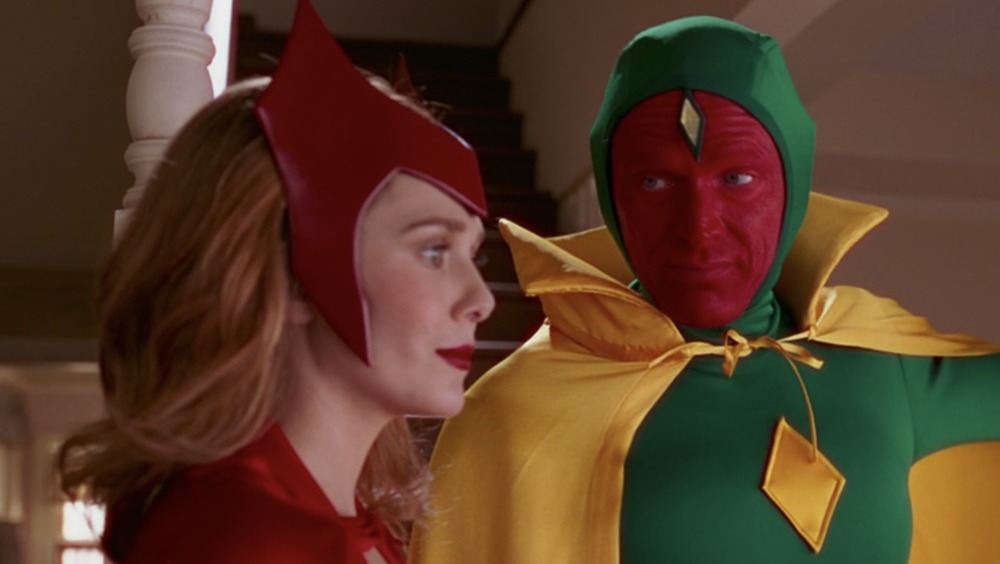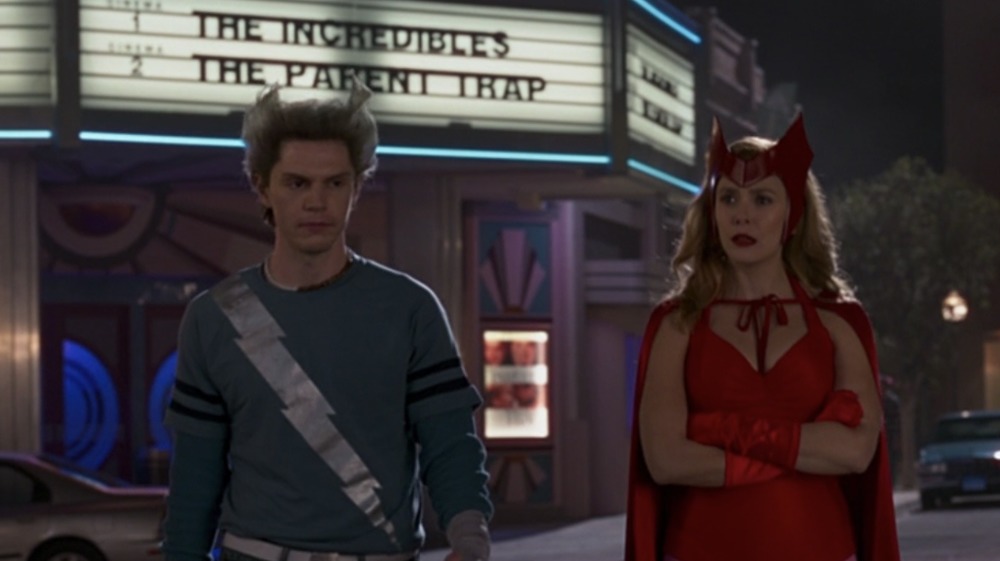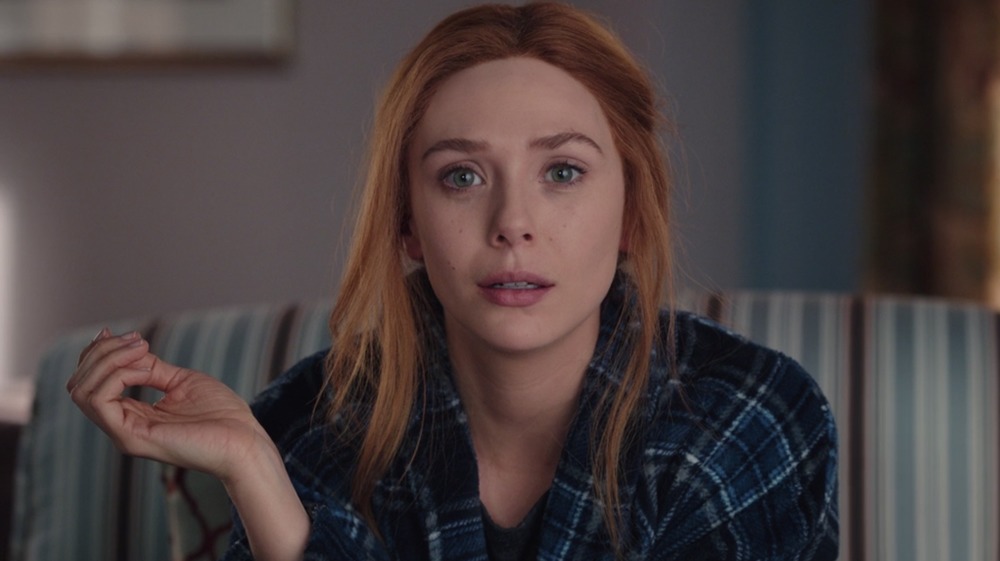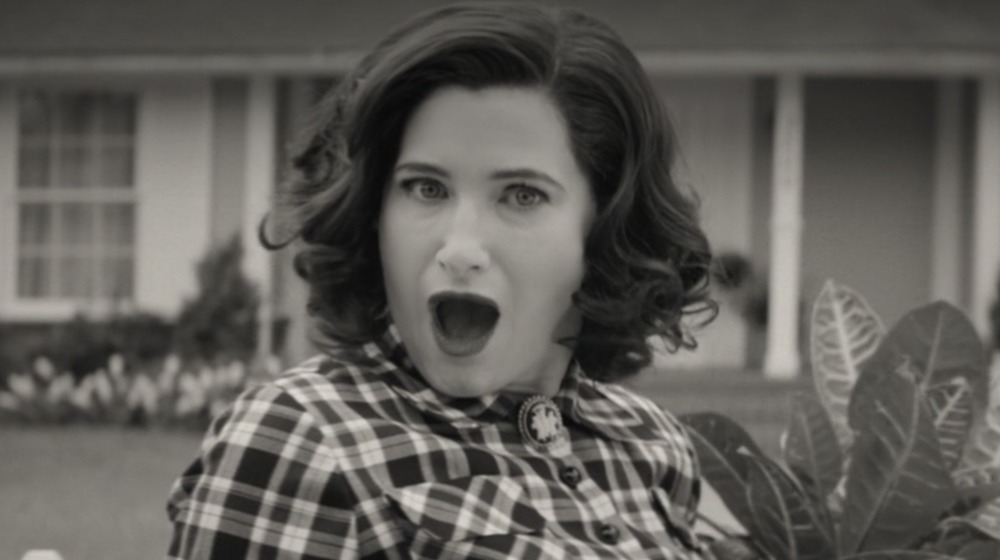Things Only Adults Noticed In WandaVision
The Marvel Cinematic Universe kicked off with movies featuring Iron Man, Thor, and Captain America, culminating in four Avengers team-up movies. As the MCU took over the box office in the 2010s, shows based on Marvel characters popped up all over the small screen, including ABC's Agents of S.H.I.E.L.D. and Netflix's Jessica Jones, and soon Marvel properties will be all over Disney+. The first of many planned shows: WandaVision, featuring two heroes whose involvement was vital to the good guys saving the day in the Avengers films, specifically Scarlet Witch, a.k.a. Wanda Maximoff (Elizabeth Olsen), and robotic Vision (Paul Bettany).
WandaVision will serve as a warm-up to a multiverse-spanning Doctor Strange sequel, but is also in the vein of the MCU's Guardians of the Galaxy in that the show is funny, goofy, strange, and just kind of out there. Each episode features Wanda and Vision stuck in a different decade's archetypal TV sitcom format, only with some bewildering twists. A show like that is going to be loaded with references and jokes that will soar right over the heads of young comics readers and MCU fans. But the adults watching will know what's what — here's all of the just for grown-ups stuff in WandaVision.
The first episodes are heavily influenced by The Dick Van Dyke Show
The Dick Van Dyke Show is one of the most influential sitcoms of all time, particularly sitcoms about hip, young, attractive couples. Rob and Laura Petrie (Dick Van Dyke and Mary Tyler Moore) are a lot like WandaVisions's Vision and Wanda, respectively, and the first two black-and-white episodes of the show thoroughly pay homage to The Dick Van Dyke Show — a comedy with which 2021 kids probably aren't familiar. The living room and entryway of WandaVision's suburban house (somewhere in the New York-New Jersey area, like the Petries') is laid out the same, with the kitchen on the far right, and the front door on the far left. In the faux-sitcom opening credits sequence, Vision carries Wanda over the threshold and nearly trips on a poorly placed chair. Instead, he glides right through it, because as a synthezoid, that's something that he can do. (On The Dick Van Dyke Show, Rob famously fell over the thing each week.)
By episode 2, some of the mid-'50s Leave It to Beaver and Donna Reed Show allusions have started giving way to early '60s sitcoms — like the 1961-'66 Dick Van Dyke. Wanda has dropped her demure dress, apron, and heels in favor of sleek black capri pants and more comfortable shoes. Add her stylish flip hairdo into the mix, and she looks just like Moore as Laura.
How the Scarlet Witch went Bewitched
Another vintage sitcom that adults are more likely to know (or having a passing understanding of) is Bewitched. The 1964-'72 high-concept sitcom concerned a witch named Samantha who married a befuddled guy named Darrin. There was no way that WandaVision, a sci-fi story told through old TV comedy tropes in which one of its two main characters is a witch, wouldn't send up or embrace Bewitched. With a point of a finger, Wanda changes the "for sale" sign on a chosen house into "sold," a very Samantha act of instantaneous magic. Also like Samantha, she uses her amazing powers to accomplish household tasks, like doing the dishes and making dinner, the latter of which she accomplishes by manifesting objects out of thin air. When his boss comes over for dinner, Vision virtually transforms into the hapless Darrin. Just as that character was often left desperately trying to keep hidden the fact that his wife was a witch, Vision vamps, sings "Yakety Yak," and tries other distraction methods to make sure his boss and his wife don't see pots, pans, and foods floating through the air in the kitchen.
And while Samantha always got a charming little musical note on the Bewitched soundtrack to underscore her magical act, Vision triggers that in WandaVision. When he makes himself drop his human disguise in favor of his real, robotic form, he does so with an amusing "bling!"
There are lots of clues about Scarlet Witch's history
Wanda Maximoff is also Scarlet Witch, reflected in her red costume and tremendous magical powers. WandaVision focuses on the Wanda part of the dual character, but her life as the Scarlet Witch is noted often in the series in the form of subtle Easter eggs.
Vision starts his day in episode one by reading the Westview Herald. The headline: "Little Baby June's First Word Tickles Mother." Comics publishers often reboot characters and give superhero identities to new people, and In one such iteration, June Covington worked under the name Scarlet Witch.
In the first episode, Wanda and Vision host the latter's boss and his wife for dinner. Wanda pours everyone a glass of "Maison du Mépris" wine. That translates to "House of Contempt," but the "M" in Mupris is so prominent it might as well read "House of M," which is the name of a Marvel Comics miniseries from 2005 in which Scarlet Witch keeps changing reality, kind of like she does at the end of episode 2 of WandaVision when she rewinds time.
And then there's vivacious neighbor Agnes (Kathryn Hahn), who we eventually learn knows more than she's letting on about Wanda's shifting reality. Agatha Harkness served as teacher and villain to Scarlet Witch in the comics, and if you take the first two letters of her first name and combine it with the suffix on her last name, you get... Agnes.
There are many subtle Iron Man references
Vision owes his life in part to Tony Stark, as the billionaire industrialist and robotics enthusiast uploaded his beloved artificial intelligence J.A.R.V.I.S. into a vibranium body made by the evil Ultron, only for Vision to consciously decide to hang with the Avengers. Tony Stark/Iron Man helped put the Avengers together, and WandaVision brings it all back to the beginning with little nods to the character.
In episode 2, Wanda is confused and a little alarmed when her black-and-white world is invaded by a full-color toy helicopter that crashes in the bushes in front of her house. She carefully holds the object, which is red and yellow — Iron Man colors. (It also bears the logo of S.W.O.R.D., the division of S.H.I.E.L.D. that fights menacing aliens.) Color appears in another of WandaVision's initial black-and-white episodes, and it's so jarring and ominous that adults will have no choice but to pay attention. The first episode includes a break for a 1950s-style TV commercial, wherein a pitchman patronizingly helps a woman operate a household appliance. In this case, it's the Toast Mate 2000, a product of Stark Industries.
The same pitchman pops up in the fake ad in WandaVision episode two, shilling a fancy "Strucker" watch, which tiny text tells viewers is made by Hydra. Wolfgang von Strucker, and Hydra, factor prominently into the earth-changing events of Avengers: Age of Ultron, as do the actions of Tony Stark... and Scarlet Witch.
That's the way they all became the WandaVision bunch
In episode three of WandaVision, the action — and Wanda and Vision's surreal and confusing reality — shifts to the early 1970s. More specifically, their world turns into a detailed re-creation of one of the most definitive sitcoms of the era: The Brady Bunch. From the beginning of the opening sequence, viewers old enough to remember the adorably cornball comedy about a huge blended family (or those old enough to have absorbed it in endless reruns) are bombarded with a bunch of Brady bits. The name of the series and the regular characters are displayed in a groovy font similar to the one used in The Brady Bunch's credits. The animation utilized — where a line turns into a big hexagon, sitting alongside other, smaller hexagons — reminds viewers of the famous Brady grid graphics.
The open sequence depicts Vision engaging in mid-century suburban activities like grilling burgers and putting together a swing set, and he's doing them both outside, past a sliding glass door in a tiny, unnaturally well-lit yard atop fake grass — it's a very Brady yard. The inside of the house also invites Brady comparisons, such as the double front doors, brick walls near the kitchen, and open, platform-style stairs. (That stairwell leads to a landing decorated with multi-colored glass — which is a reference to the color scheme of the family band's bus on Brady Bunch contemporary The Partridge Family.)
WandaVision includes a very sitcom pregnancy
The plot of WandaVision's third episode revolves around Wanda's sudden, unexpected, and extremely rapidly progressing pregnancy. As that occurs in the environment of a '70s sitcom, the show embraces and sends up the many tired clichés frequently foisted upon pregnant characters.
Like many sitcom dads-to-be before him, Vision tries to prepare for the baby's arrival with logic and knowledge, devouring books on pregnancy. He's a good source of info for Wanda, teaching her about things like breathing exercises to deal with pain — just like other comedy characters who would attend a Lamaze class. In decades past, the big dramatic moment that lets the audience know the birth is imminent is when the mother's water breaks, and that happens to Wanda, although WandaVision subverts the idea — it comes in the form of a torrential indoor rainstorm.
Adults will recognize a couple of other jokes if they've ever been through a real-life pregnancy. Vision brings in a doctor who compares the growth of a baby at different stages to different fruits, some of which appear later in the episode; a pineapple is about the size of a baby almost ready for delivery, for example, and Wanda prepares that very fruit later on. And when Geraldine makes an unexpected visit, Wanda conceals her "baby bump" with a bowl of fruit — just like when pregnant actors play non-pregnant characters on sitcoms and spend months behind strategically placed laundry baskets or grocery bags.
Family Ties bind Wanda and Vision
Almost immediately after opening Disney+ and hitting play on the fifth episode of WandaVision, mature viewers will realize that this episode takes place in the '80s and the sitcom of that era it will most explicitly emulate is Family Ties, the 1982-1989 smash about Steven and Elyse Keaton, former '60s hippies who move to the suburbs to raise their conservative and superficial '80s kids. WandaVision's set in this episode is dressed to resemble the Keatons' Columbus, Ohio, home, what with the dark wood flourishes, small glass windows, and central yellow couch. Vision even rocks Steven Keaton's usual wardrobe of a plaid shirt tucked into jeans. One of the most memorable elements of Family Ties, for those old enough to remember, was an opening sequence in which a line drawing portrait of the Keatons is slowly filled in with paint. WandaVision's credit sequence re-creates that, albeit with an independently moving magic wand-like brush doing the painting.
And finally, when Wanda's dead brother Pietro shows up at the end of the episode, he takes the form of a guy in a leather jacket with a New York accent who's sweet (he asks for a hug) and a little crude (he looks at Vision and asks who "the popsicle" is). Producers likely meant for this "recast" Pietro to at least slightly resemble Nick, the rebellious, dim-bulb artist Mallory Keaton dated on Family Ties.
When WandaVision experienced some Growing Pains
Apart from the magical self-filling painting, the opening sequence of the '80s-sitcom-style episode of WandaVision is all about the 1985-'92 hit Growing Pains. That show, ABC's answer to NBC's The Cosby Show, is also about a wealthy New York City family in which the father is a doctor. Older WandaVision viewers will remember Growing Pains' simultaneously sweet, maudlin, and abrasive opening credit sequence, which the MCU show re-creates while lovingly poking fun at the whole thing. Set to a theme song like the one from Growing Pains, with mawkish and overly sentimental lyrics about family and love sung over bright electric guitar riffs, the visuals consist of a pastiche of baby, childhood, and supposedly long-ago photos of Wanda, Vision, and family growing up... just like its '80s sitcom inspiration. Growing Pains' visual style makes one more appearance toward the end of the episode. Wanda, not wanting to listen to Vision confront her about her cruel manipulation of time, space, and lives, makes her TV life's credits roll, and they're in the same typeface as those from Growing Pains.
Older viewers may have noticed that WandaVision seemingly had one more Growing Pains reference saved up for its series finale. Pietro, Wanda's dead brother, "recast" in her TV-emulating world with a new actor, is revealed to be a chuckling, slightly dim performer named Ralph Bohner. That's pronounced "Boner," the name of Mike Seaver's chuckling, slightly dim best friend on Growing Pains.
The real reason why the twins on WandaVision grew up so fast
In Wanda's concocted sitcom world of Westview on WandaVision where all of her deceased loved ones are still alive, much of the mystery focuses on her twin sons, Tommy and Billy. In Marvel Comics and the Marvel Cinematic Universe, Wanda has kids by those names, but on WandaVision, especially during episode five, they're a vehicle to send up the presentation of children in '80s TV comedies. At the beginning of the fifth installment of the series, Tommy and Billy are infants, by the middle they're kindergarten age, and they're ten years old by the time the episode concludes. Their rapid growth is both a function of Wanda's seemingly disturbed mind and reflective of how sitcoms in the '80s routinely did this. For example, Andrew Keaton on Family Ties and Chrissy Seaver on Growing Pains both went from baby to wisecracking grade-schooler in just a few months, and their quick aging was never acknowledged. It is on WandaVision, with Wanda telling Vision that it doesn't matter if Agnes sees her do magic because "She didn't even notice when the boys went from babies to five-year-olds." Attentive adult viewers will probably also recognize that Tommy and Billy, at both age five and 10, don't look alike at all. They're TV twins, like the similarly different Mark and Willie on the '80s sitcom The Hogan Family.
Everywhere you look, there's a Full House reference
Speaking of twins, the most famous and popular '80s sitcom — whose language WandaVision heavily relies on in its fifth episode — involving identical children is Full House. This particular installment includes a few references to that 1987 to 1995 family-friendly hit. When anybody does anything sentimental or cute on WandaVision, the studio audience emits a treacly "aww," for example, and toddler-aged Tommy and Billy are reminiscent of Nicky and Alex, Uncle Jesse and Aunt Becky's tiny tot twins. In the opening credit sequence, Wanda, Vision, and their kids run through the rolling field in the town square toward the camera and end the sequence with an idyllic picnic, captured in a wide shot. Both of those moments are instantly recognizable to viewers of a certain age as straight out of the Full House opening. This is all amusing on another level, too. Michelle Tanner on Full House was portrayed by twins Mary Kate and Ashley Olsen, the older sisters of Elizabeth Olsen... who stars as Wanda on WandaVision.
It's Wanda in "the Middle"
By episode six of WandaVision, Wanda Maximoff was still living in a television-based alternate world of her own creation which evolves each week to correspond to an increasingly recent real-life sitcom. In this installment, Wanda moves from the '80s and early '90s tropes of Family Ties and Growing Pains to get to the edgier, rougher, single-camera, laugh track-free comedies of the 2000s, particularly Malcolm in the Middle. The first third of WandaVision's sixth episode is packed with homages and references to the 2000 to 2006 Fox hit — something a bit before younger viewers' time. The opening sequence of the older show featured harried mom Lois (Jane Kaczmarek) caught in a towel, and WandaVision's intro segment — similarly shot frenetically and with lots of video feedback and footage discoloration — finds Wanda brushing her teeth, not thrilled about getting captured on a camcorder. Character names, presented as credits, appear in a similar font as the one utilized on Malcolm.
Then, once the action of the show starts, Billy and Tommy break the fourth wall and address the audience directly, a device employed by Malcolm (Frankie Muniz) throughout that series' run. Jaunty ska-flavored music plays lightly on the soundtrack as they do, a nod to Malcolm's similar score. WandaVision also emulates Malcolm's visual style here, employing the use of quick wipe cuts and odd camera angles.
Those Halloween costumes are a clever throwback
Because WandaVision is a sitcom — or at least a show set in an artificial, sitcom-derived world — it gets a Halloween episode. The MCU series' sixth installment finds Wanda, Vision, the twins, and Pietro celebrating the big fall holiday, and they dress up for the occasion in form-fitting, brightly-colored Halloween costumes that are too cheap, cheesy, and flashy to not be designed to catch older viewers' attention, and to make them search their brains as to why those outfits seem so familiar.
The reason is also an in-joke for Marvel Comics fans. Wanda, a.k.a. Scarlet Witch, and Vision, mostly hiding their superhero identities, don't often appear on WandaVision in their crimefighting costumes. But on Halloween, they dress up in re-creations of the superhero costumes they wore in Marvel Comics adventures published long ago. In print, Wanda wore a pointy headpiece, cape, and leotard, just like she does here, while Vision's green bodysuit and yellow cape is also comics-appropriate. Even Pietro gets in on the fun, donning a blue T-shirt with a silver stripe and hair fluffed upward, resembling the inked version of his super alter ego Quicksilver.
Now playing in Westview: a revealing joke
Westview is an idyllic small town, straight out of a nostalgic vision of America's past, its downtown and town square similar to the backlot of a studio where old sitcoms were shot or Disneyland's Main Street U.S.A. It's all so eerily perfect because Westview is a creation of Wanda Maximoff's powerful imagination, and she's thought of every last, perfect detail. In episode six, Wanda and her family attend Westview's outdoor Halloween festival, held just outside the Coronet, the town's old-fashioned movie house. The marquee proclaims that two films are currently playing: The Incredibles and The Parent Trap. Not only are these both Disney properties (like WandaVision and the Marvel Cinematic Universe), but it's also a nod to older viewers who will get the joke. The Incredibles is about a family of superheroes — much like Wanda, Vision, and high-powered twins Billy and Tommy. The Parent Trap, in all of its iterations, is about mischievous twins — like Billy and Tommy — who have also been separated a long time and are trying to get to know each other again... like Wanda and the recently resurfaced Pietro.
The Coronet's marquee gets a couple more switcheroos. In the eighth episode, it displays the names of movies called Big Red and Kidnapped. Wanda has big powers and red is her signature color in Scarlet Witch mode, while "kidnapped" is what Agnes does to her and the twins. Then, in the final episode of WandaVision, as the magical Hex disappears and Westview returns to its regular reality, the movie advertised is Oz the Great and Powerful. The 2013 Disney-produced prequel to The Wizard of Oz concerns a circus magician winding up in a magical land controlled by powerful, dark witches — not unlike Westview under the spell of Wanda and Agnes.
Modern WandaVision
The term "breaking the fourth wall" refers to when an actor addresses viewers directly, dissolving the invisible barrier between worlds. It can also be used to describe that thing in 21st century mockumentary sitcoms where characters appear in confessional segments to explain their thoughts and actions, or turn to the camera to react to the behavior of others. Those are all tropes of Modern Family, and the seventh episode of WandaVision, "Breaking the Fourth Wall," is full of homages to the Emmy-winning ABC smash.
Wanda is starting to crack under the pressure of maintaining a faux sitcom world, and she decides to grab some "me time," all of which she discusses by talking right to the camera, which fidgets ever so slightly and jaggedly zooms in on her face every so often to mimic the handheld style of Modern Family. Her "talking head" segment is delivered with a striped chair that WandaVision producers seemingly took right off the set of Modern Family, which also inspired this episode's look, with its black and white interior design and expensive-looking furniture. The jazzy big-band drums on the soundtrack also remind older viewers of that popular sitcom, as do Vision and Agnes silently expressing alarm over Wanda's actions for the benefit of the viewer.
The opening credit sequence borrows Modern Family's typeface, but the style — with rapid-fire examples of "Wanda" appearing on real-life objects — comes straight from Happy Endings, a sitcom that once came on right after Modern Family.
The episode titles play into WandaVision's classic TV themes
When new installments of WandaVision hit Disney+ at the stroke of midnight on each consecutive Friday during its run, individual episode titles were not immediately revealed, noted instead by just a number. Perhaps that was to hide the plot developments in each episode as long as possible, because the eventually listed names suggest a lot about what happened each week. Additionally, they're all television-related phrases that, like many WandaVision episodes themselves, harken back to days of yore, long before 2020s kids were absorbing entertainment.
"Filmed Before a Live Studio Audience" refers to the announcement made on old sitcoms to suggest to viewers at home that the laughs were real, not from a laugh track. "Don't Touch That Dial" was said on mid-century shows before commercial breaks to discourage manually tuning the TV to another station. "Now in Color" was a marketing tactic employed to get people to watch older, previously black-and-white programs that had made the technological upgrade to color. The title of the eighth episode, "Previously On," hints at the breadth of Wanda's backstory shown in the form of flashbacks, necessitating this episode title taken from something an actor might say at the beginning of an episode to provide viewers with a recap of previous plot developments.
